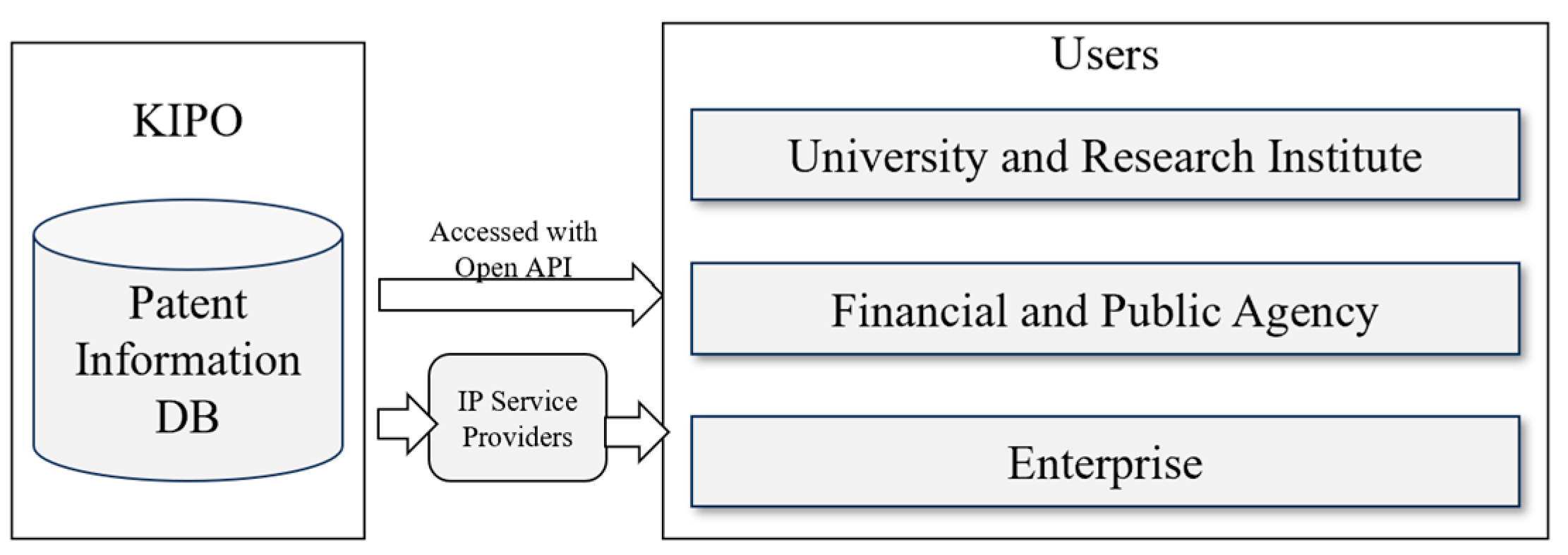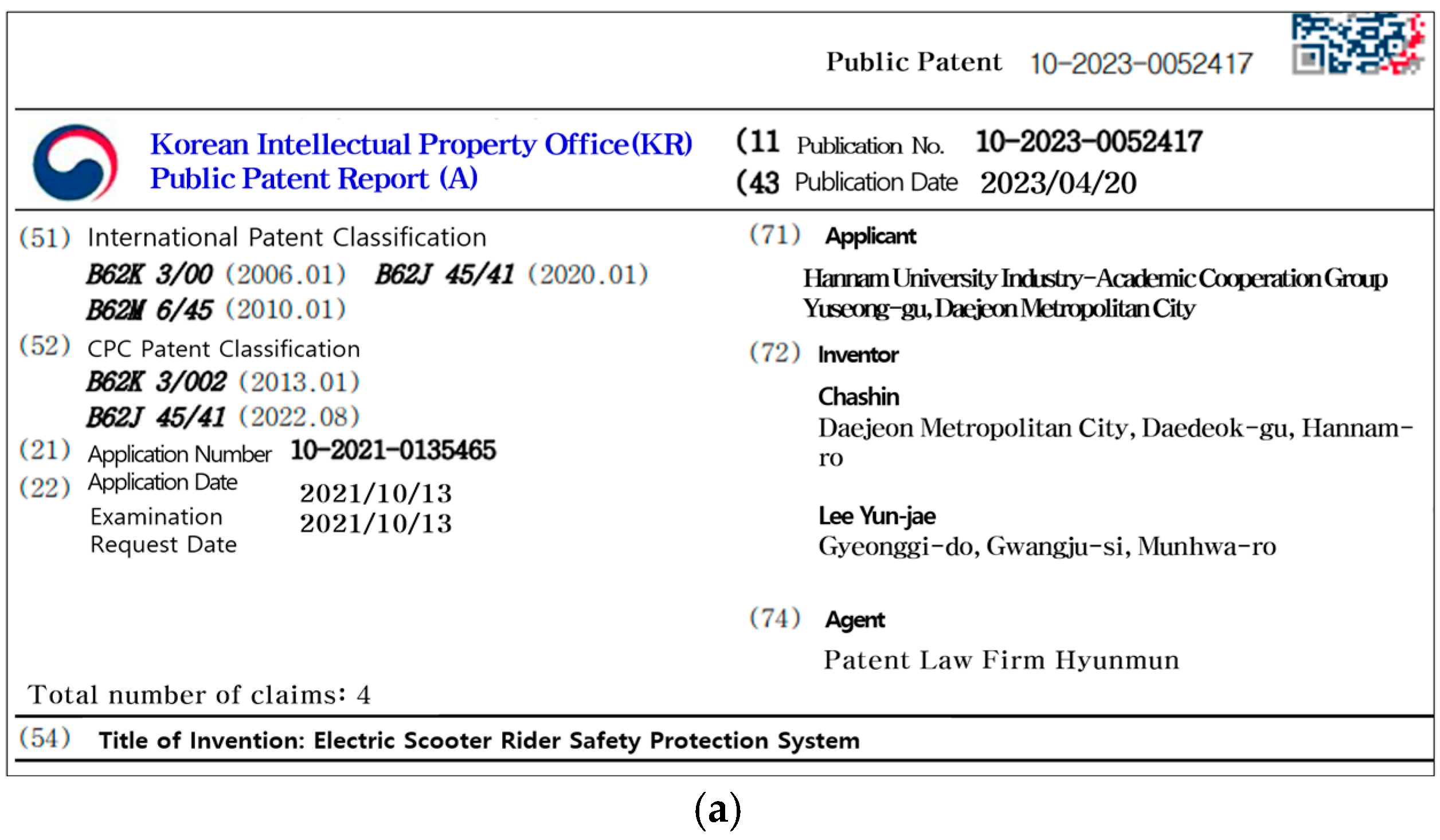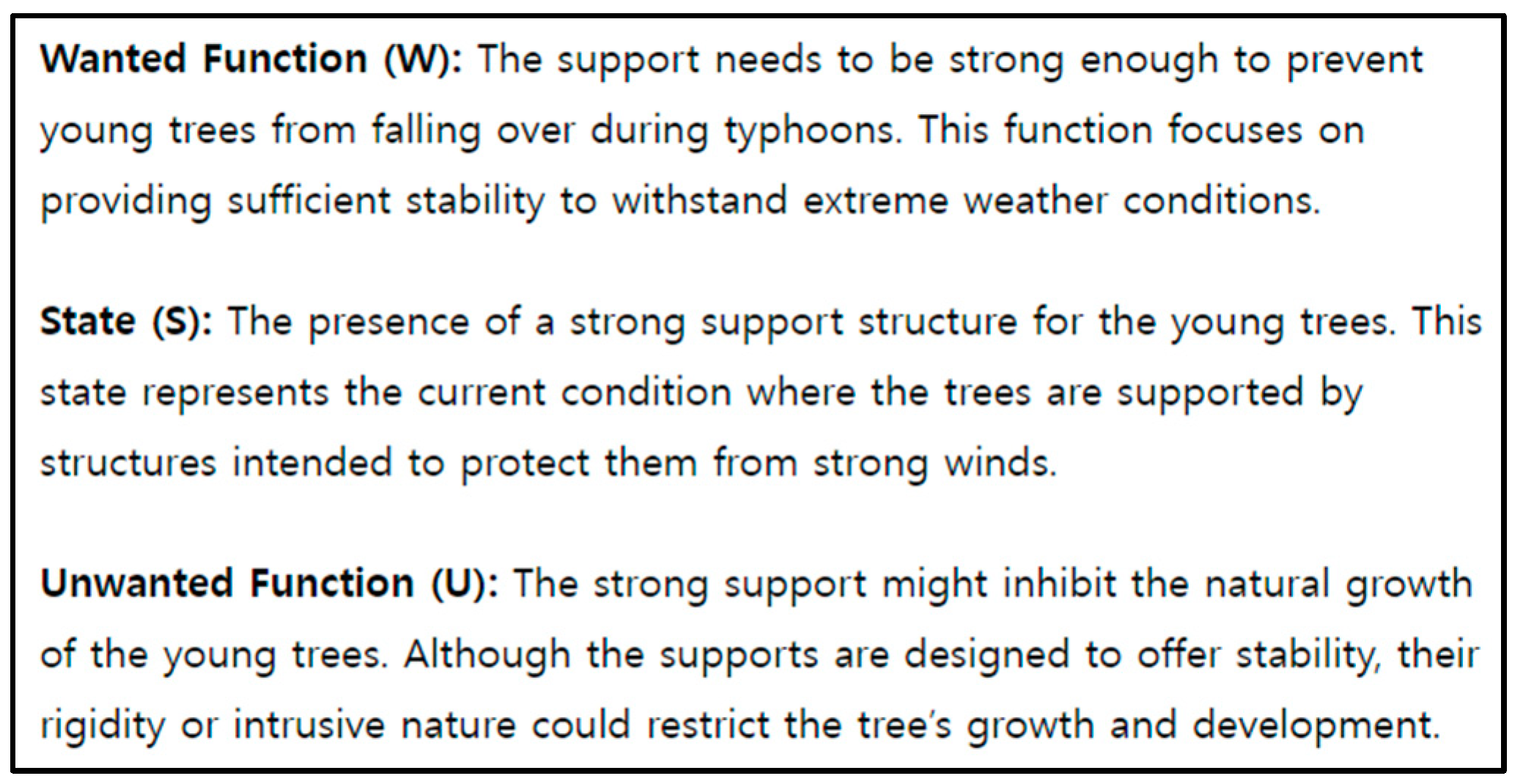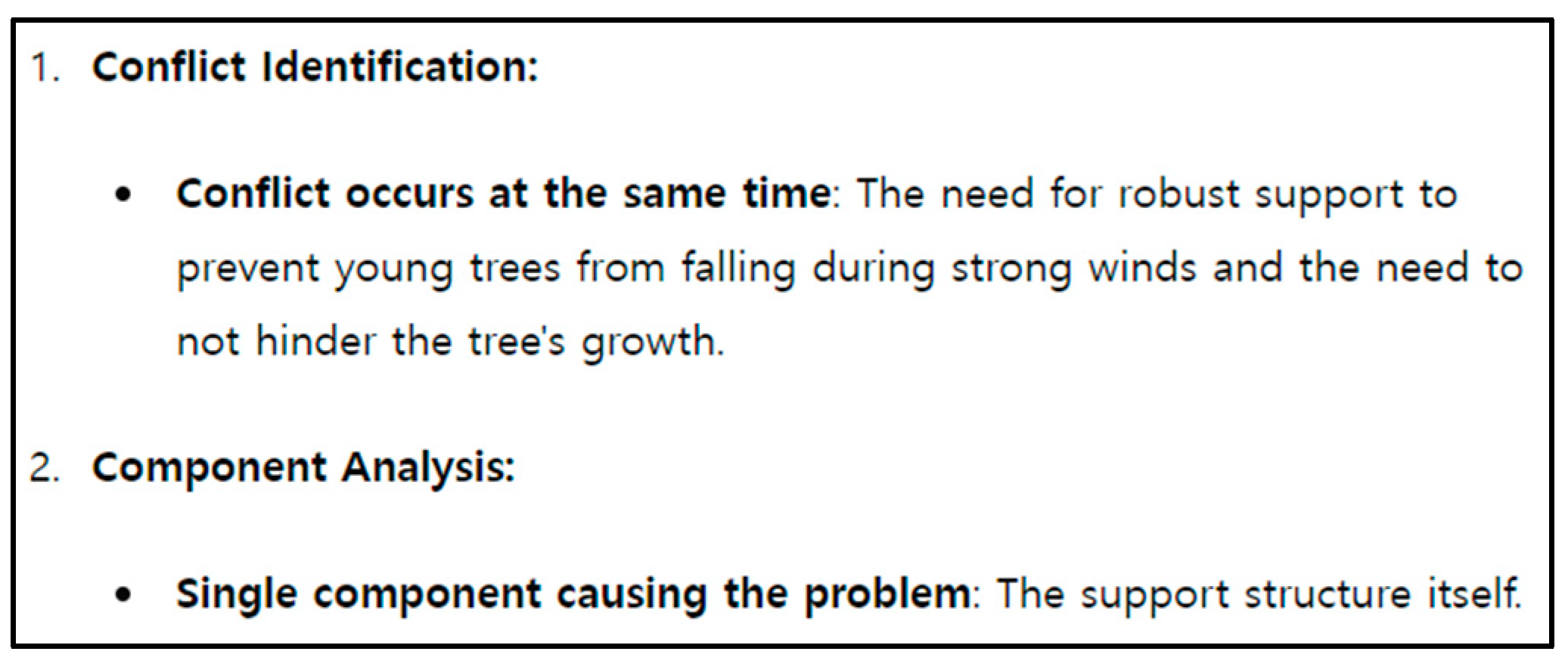RoBuCACO: ChatGPT-Based Educational Model for Creative Problem-Solving †
Abstract
1. Introduction
2. Butterfly Model for Contradiction Resolution
2.1. Butterfly Model
2.2. Butterfly Diagram
2.3. Butterfly Algorithm
| Algorithm 1. Butterfly Algorithm |
| If (a conflict occurs at the same time) then if (the number of components causing the problem is single) then if (the component can be partially removed) then DO prior extraction of the component else DO alternative selection else if (the components serve a single purpose) then DO division and combination of components decomposing a single system else if (there is homogeneity among the components) then DO division and combination of components for the whole/part else DO division and combination of components forming multiple systems else if (the number of components causing the problem is single) then if (the component can be partially removed) then DO posterior extraction of the component else DO time division and combination else if (the components serve a single purpose) then DO division and combination of components decomposing a single system else if (there is homogeneity among the components) then DO division and combination of components for the whole/part else DO division and combination of components forming multiple systems |
3. Educational Model: RoBuCACO
3.1. Role Definition (Ro)
- ChatGPT is used to understand the context of the text and extract important information.
- ChatGPT defines the desirable function, the state resulting from the function, and the problems that the state causes in order to define contradictions.
- ChatGPT suggests various problem-solving strategies.
3.2. Learning About the Butterfly Model (Bu)
3.3. Problem and Contradiction Definition (C)
3.4. Abstract Solution Strategy Definition (A)
3.5. Concrete Solution Strategy Finding (C)
3.6. Refinement for Finding the Optimal Solution (O)
4. Generation and Creative Problem-Solving with RoBuCACO
- Safety System: The patent discusses a safety system specifically designed for electric scooters.
- Detection System: Various detection systems, such as helmet-wearing and alcohol-level detection, are mentioned.
- Helmet Detection: A system for detecting whether a helmet is being worn by the rider.
- Alcohol Detection: The document details a system for detecting the alcohol level of the rider.
- Electric Scooter: The document focuses on technologies related to electric scooters, particularly their operation and safety features.
- Adjustable Rings: Utilize adjustable support rings that can be expanded as the tree grows in girth. These rings should be attached to vertical stakes that can also be adjusted for height.
- Flexible Material: Construct the support rings and vertical stakes using a flexible material such as high-density polyethylene (HDPE) which has enough strength to withstand strong winds but enough flexibility to move slightly with the tree. This flexibility minimizes the risk of damaging the bark or restricting growth.
- Modular Setup: Design the support structure in segments or modules that can be easily added or removed. As the tree grows taller and thicker, additional modules can be attached to accommodate this growth without needing to replace the entire system.
5. Conclusions
Author Contributions
Funding
Institutional Review Board Statement
Informed Consent Statement
Data Availability Statement
Conflicts of Interest
References
- Ikenson, B. Patents: Ingenious Inventions How They Work and How They Came to Be; Running Press: Philadelphia, PA, USA, 2012. [Google Scholar]
- Watkins, P. From Hell Island to Hay Fever; Brown Dog Books: Bristol, UK, 2018. [Google Scholar]
- Piccard, A. Earth, Sky, and Sea; Oxford University Press: Oxford, UK, 1956. [Google Scholar]
- Bessemer, H. Sir Henry Bessemer F R S: An Autobiography; Offices of Engineering: Tokyo, Japan, 1905. [Google Scholar]
- Pelkey, J. Greimas embodied: How kinesthetic opposition grounds the semiotic square. Semiotica 2017, 214, 277–305. [Google Scholar]
- Polya, G. How to Solve It: A New Aspect of Mathematical Method; Princeton University Press: Princeton, NJ, USA, 1971. [Google Scholar]
- Helnwein, G. Gespräch Mit Gottfried Helnwein Anlässlich der Eröffnung Seines Virtual Museums of Art in “Second Life”. Available online: https://www.helnwein-museum.com/ (accessed on 5 February 2024).
- Rucker, R. Mind Tools: The Five Levels of Mathematical Reality; Dover Publications, Incorporated: Mineola, NY, USA, 2013. [Google Scholar]
- Peng, K.; Nisbett, R.E. Culture, dialectics, and reasoning about contradiction. Am. Psychol. 1999, 54, 741–754. [Google Scholar] [CrossRef]
- Altshuller, G. Creativity as an Exact Science: The Theory of the Solution of Inventive Problems; CRC Press: Boca Raton, FL, USA, 1984. [Google Scholar]
- Fey, V.; Rivin, E. Innovation on Demand: New Product Development Using TRIZ; Cambridge University Press: Cambridge, UK, 2005. [Google Scholar]
- Zlotin, B.; Zusman, A.; Altshuller, G.; Philatov, V. Tools of Classical TRIZ; Ideation International Inc.: Southfield, MI, USA, 1999. [Google Scholar]
- Zia-Ul-Haq, M.; Mujtaba, G. ChatGPT and patent eegime: Key legal concerns. Trends Intellect. Prop. Res. 2023, 1, 18–26. [Google Scholar]
- Borger, J.G.; Ng, A.P.; Anderton, H.; Ashdown, G.W.; Auld, M.; Blewitt, M.E.; Brown, D.V.; Call, M.J.; Freytag, S.; Harrison, L.C.; et al. Artificial intelligence takes center stage: Exploring the capabilities and implications of ChatGPT and other AI-assisted technologies in scientific research and education. Immunol. Cell Biol. 2023, 101, 923–935. [Google Scholar] [CrossRef] [PubMed]
- Hyun, J.S.; Park, C.J. Logical interpretation about problem types and solution strategies of the butterfly model for the automation of contradiction-based problem solving. In Proceedings of the 2014 IEEE International Conference on Teaching, Assessment and Learning for Engineering (TALE), Wellington, New Zealand, 8–10 December 2014; pp. 236–241. [Google Scholar]
- Hyun, J.S.; Park, C.J. The butterfly algorithm: A contradiction solving algorithm based on propositional logic for TRIZ. Int. J. Softw. Eng. Its Appl. 2016, 10, 27–34. [Google Scholar]
- Rajić, D. Mathematical-physical model of solving inventive problems. FME Trans. 2021, 49, 726–733. [Google Scholar] [CrossRef]
- Rajić, D. Innovative synergism as a result of TRIZ and LT-system synthesis. In Innovation as an Initiator of the Development “Innovations—Development Prospects”; Faculty of Applied Management, Economy and Finance: Belgrade, Serbia, 2019; pp. 226–242. [Google Scholar]
- Govindarajan, U.H.; Sheu, D.D.; Mann, D. Review of systematic software innovation using TRIZ. Int. J. Syst. Innov. 2019, 5, 72–90. [Google Scholar]
- Jani, H.M. Teaching TRIZ problem-solving methodology in higher education: A review. Int. J. Sci. Res. 2013, 2, 98–103. [Google Scholar]
- Wang, F.; Peng, Q.; Tan, R.; Wang, K.; Zhang, S.; Sun, J. An attribute-based method for identifying implicit contradictions in product development. Comput.-Aided Des. Appl. 2022, 20, 439–455. [Google Scholar]
- Hyun, J.S.; Park, C.J. The Butterfly algorithm eliminating the brute-force mechanism in ARIZ for contradiction problem solving. In Proceedings of the 2015 8th International Conference on Security Technology (SecTech), Jeju, Republic of Korea, 25–28 November 2015; pp. 25–27. [Google Scholar]
- Hyun, J.S.; Park, C.J. Innovative contradiction solving dimensions and algorithms. J. Adv. Inf. Technol. Converg. 2017, 7, 1–10. [Google Scholar]
- Hyun, J.S.; Park, C.J. Effects of the Butterfly diagram education in primary and secondary schools on contradiction problem solving ability. In Proceedings of the 2015 IEEE Frontiers in Education Conference (FIE), El Paso, TX, USA, 21–24 October 2015; pp. 1–8. [Google Scholar]







| Title 1 | s → h | s ă← h | s ↔ h |
|---|---|---|---|
| d → s | (d → s) ∧ (s → h) | (d → s) ∧ (s ← h) | (d → s) ^ (s ↔ h) |
| d ← s | (d ← s) ∧ (s → h) | (d ← s) ∧ (s ← h) | (d ← s) ∧ (s ↔ h) |
| d ↔ s | (d ↔ s) ∧ (s → h) | (d ↔ s) ∧ (s ← h) | (d ↔ s) ∧ (s ↔ h) |
| Contradiction Problem Types | Problem-Solving Goal | Abstract Problem-Solving Strategy |
|---|---|---|
| (d → s) ∧ (s → h) | d ⊕ ∼h | s ⊕ ∼s |
| (d ← s) ∧ (s → h) | d ∧ ∼h | d ∧ ∼s |
| (d ↔ s) ∧ (s → h) | d ⊕ ∼h | s ⊕ ∼s |
| (d → s) ∧ (s ← h) | d ∧ ∼h | s ∧ ∼h |
| (d ← s) ∧ (s ← h) | d ∧ h | d ∧ s |
| (d ↔ s) ∧ (s ← h) | d ∧ ∼h | s ∧ ∼h |
| (d → s) ∧ (s ↔ h) | d ⊕ ∼h | s ⊕ ∼s |
| (d ← s) ∧ (s ↔ h) | d ∧ ∼h | d ∧ ∼s |
| (d ↔ s) ∧ (s ↔ h) | d ⊕ ∼h | s ⊕ ∼s |
Disclaimer/Publisher’s Note: The statements, opinions and data contained in all publications are solely those of the individual author(s) and contributor(s) and not of MDPI and/or the editor(s). MDPI and/or the editor(s) disclaim responsibility for any injury to people or property resulting from any ideas, methods, instructions or products referred to in the content. |
© 2025 by the authors. Licensee MDPI, Basel, Switzerland. This article is an open access article distributed under the terms and conditions of the Creative Commons Attribution (CC BY) license (https://creativecommons.org/licenses/by/4.0/).
Share and Cite
Hyun, J.-S.; Park, C.-J. RoBuCACO: ChatGPT-Based Educational Model for Creative Problem-Solving. Eng. Proc. 2025, 89, 40. https://doi.org/10.3390/engproc2025089040
Hyun J-S, Park C-J. RoBuCACO: ChatGPT-Based Educational Model for Creative Problem-Solving. Engineering Proceedings. 2025; 89(1):40. https://doi.org/10.3390/engproc2025089040
Chicago/Turabian StyleHyun, Jung-Suk, and Chan-Jung Park. 2025. "RoBuCACO: ChatGPT-Based Educational Model for Creative Problem-Solving" Engineering Proceedings 89, no. 1: 40. https://doi.org/10.3390/engproc2025089040
APA StyleHyun, J.-S., & Park, C.-J. (2025). RoBuCACO: ChatGPT-Based Educational Model for Creative Problem-Solving. Engineering Proceedings, 89(1), 40. https://doi.org/10.3390/engproc2025089040






